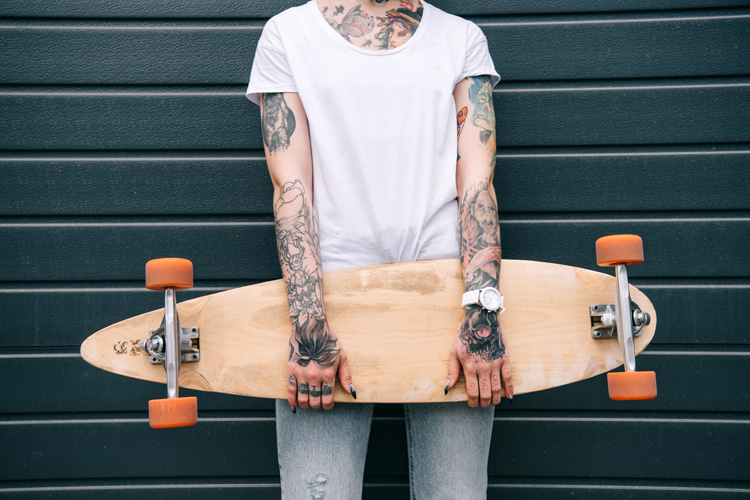The longboard is one of the most popular types of skateboards. Here's everything you need to know about the classic sidewalk surfing board.
Riders use longboard skateboards for several purposes and in several contexts and skateboarding disciplines, including downhill, freestyle, slalom, street luge, cruising, carving, and dancing.
Technically speaking, a longboard is a large skateboard that ranges from 38 inches to 60 inches (96-152 centimeters).
The name has its origins in longboard surfboards, which are much larger than traditional shortboards.
Longboard wheels are also larger (60-80 mm) and softer (durometer hardness at around 78-82), ensuring a smooth ride and less hangup on sidewalk cracks.
Nearly all traditional, regular-sized skateboard manufacturers and brands feature longboard models in their portfolios.
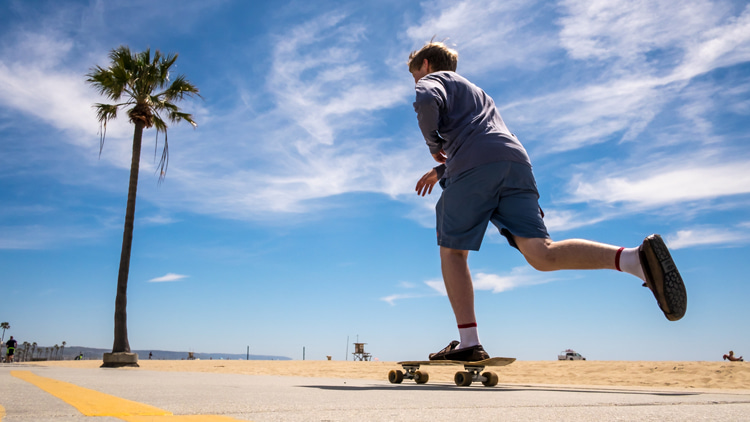
History of the Longboard
Preston Nichols was one of the first to build a longboard in the late 1940s and early 1950s.
The goal was to keep surfers entertained and fit while waiting for ideal ocean swells.
The practice, which involved custom-built planks of wood with metal wheels, gave birth to the expression "sidewalk surfing."
Actually, the first longboard skateboard models were inspired by 1950s and 1960s long wooden surfboards - they had a similar shape and, in a way, behaved identically.
Los Angeles multi-sports athlete Tom Sim - born Thomas Paul Simeon - is often regarded as the "father of the longboard."
The skate-and-snow pioneer and founder of Sims Skateboards started building large boards using water skis in the 1970s.
"Tom was known for his extremely fluid style with a longboard," notes Michael Brooke, author of "The Concrete Wave."
"He originally started with water skis and experimented with a variety of wood and wood laminates. Other longboard pioneers of the 1970s were Ed Economy and Brad Stradlund."
Sims competed in and won contests and began producing commercial longboards in five different lengths up to 48 inches (121 centimeters).
These innovators drew lines with their boards inspired by surfers like Gerry Lopez, Montgomery "Buttons" Kaluhiokalani, and Larry Bertlemann.
Later, Brad Stradlund would add the influence of Jay Adams and Tom Inouye into his longboarding riding style.
"Going fast, carving lines and pretty much like I'm pretending that I'm surfing on the pavement," added Ed Economy.
Hobart "Hobie" Alter was one of the first to get into the longboard business.
Around 1964, the legendary water sports entrepreneur designed a new board called "The Hobie Super Surfer Skateboard by Vita-Pakt."
The co-branded product featured a wood laminate deck and oak deck, steel wheels, and a triangular label.
Alter would start the Hobie Super Surfer skateboard team featuring Danny Schaefer, Danny Bearer, George Trafton, and Dave and Steve Hilton.
The investment paid off.
The boards were a commercial success; the team reached several contest podiums, and "The Hobie Super Surfer Skateboard" eventually crossed the Pacific Ocean and reached Hawaii.
Makaha Surf & Ski Surfboards (Santa Monica, California) and Jack's Surfboards (Huntington Beach, California) also helped boost the long skateboard's popularity.
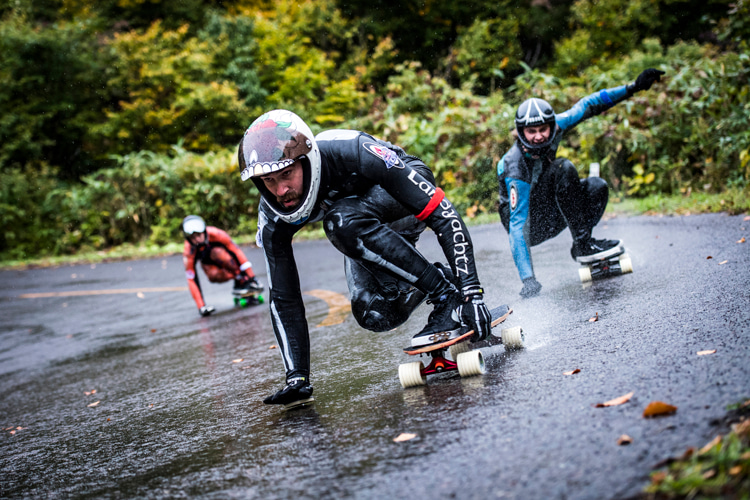
The Rebirth
After a sudden decline in the second half of the 1960s, the longboard fever returned with the introduction of the urethane wheel by Cadillac Wheels in 1973 and the revolutionary reverse kingpin system.
The reverse kingpin truck was a critical innovation in the quick development of downhill skateboarding.
In the early 1990s, longboard skateboards incorporated cutout decks that prevented wheels from touching the board during abrupt and hard turns.
The revival of longboarding was led by La Jolla residents Steve Lake and Dennis Telfer, founders of Sector 9, in 1993.
The duo wanted to design a skateboard that rode like a surfboard or snowboard.
The brand grew exponentially, and other companies like Gravity Boarding Company (Gravity Skateboards), Decomposed, Pavel, and Sk8Kings followed in Sector 9's footsteps.
New truck systems were also designed to provide greater stability, better turning, and the feel you're riding a wave on concrete.
"In 1993, longboards have sometimes even rivaled shortboard sales," states Iain Borden, author of "Skateboarding and the City."
With the advent of the X Games era, street luge became a popular underground discipline, too.
Lying down on the boards, skaters started bombing down hills at speeds of over 70 miles per hour (112 kilometers per hour) with much less wind resistance than their fellow stand-up racers.
In the 2000s, Southern California skaters equipped decks with off-road monster trucks and wheels and began propelling themselves up and down trails with poles.
The new outdoor activity resembles stand-up paddleboarding.
In Northern California, sidewalk surfers grabbed trainer kites and got themselves pulled forward, harnessed by wind power.
"In 2014, US sales of conventional completes (fully-assembled deck, trucks, and wheel packages) for street and skatepark-riding were only just ahead of longboard completes for downhill and cruising," adds Borden.
Also, in 2014, Kamloops, Canada, debuted the world's first longboard track, a C$100,000 investment that created a 380-meter downhill path with 14 bends and hairpins for sliding and drifting.
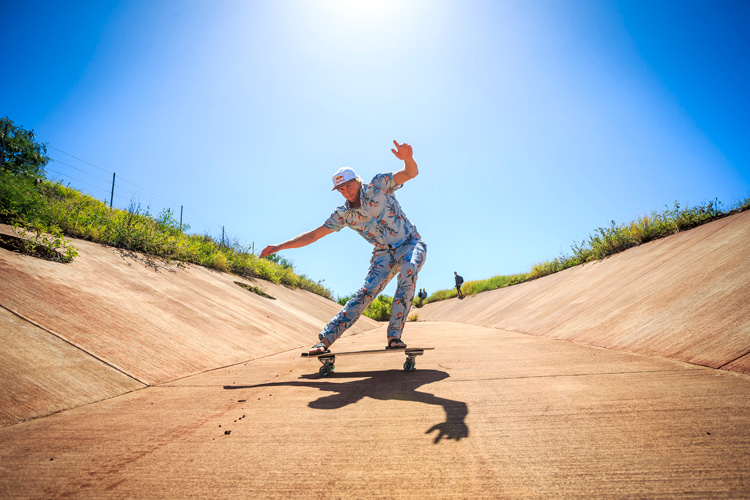
How, When, and Where to Ride a Longboard
Longboard skateboards are the perfect sidewalk surfing equipment for beginners, intermediate, and advanced riders of all ages.
These long planks of wood provide a soft, cushioned ride and are incredibly forgiving in concrete, tarmac, and other smooth surfaces.
"The ideal location to ride a longboard is a long, winding path or open road with little to no car traffic - bike paths, beachfront boardwalks, and low-traffic roads," underlines Matt Berger.
The longboard is not the weapon of choice for areas with obstacles like curbs, vert ramps, and stairs. But they're built for rough terrains.
"Thanks to the big, bouncy wheels, longboard skateboards can roll right over rocks and twigs that would send a street deck rider flying through the air, so they're able to navigate more terrain."
On the other hand, the ultra-specific downhill longboard is built to bomb more or less steep hills and mountain roads at high speed.
Downhill decks can also be used for commuting and cruising around. And they're always fun to ride.
The longboard is a versatile skateboard and one of the most environmentally friendly urban means of transportation.
More and more technical skaters include a longboard in their quivers.
It is also the go-to cross-training exercise for average and professional surfers and snowboarders.
Today, longboarding is more than a trend or movement - it's a well-established, growing skateboarding discipline.
"The realization that there were different types of skating that didn't involve ollies and ramps took me by surprise," longboarder Justin Metcalf once said.
"I got my first longboard, and I felt I was re-learning how to skate."
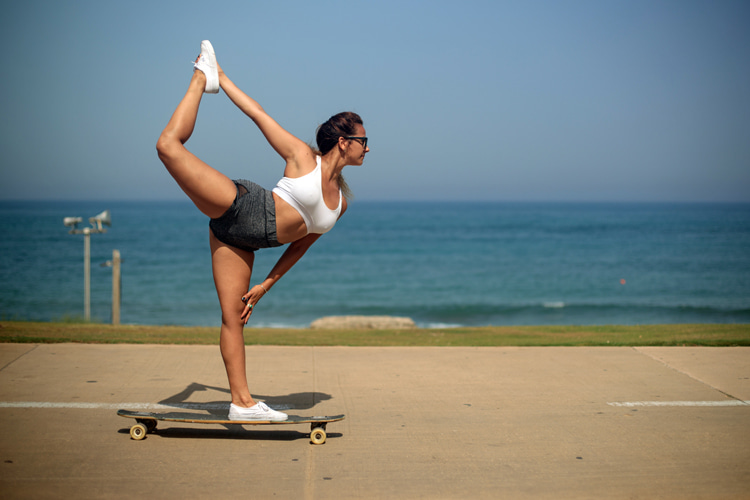
Deck, Wheels, and Trucks Dimensions
Classic longboards often feature seven to nine layers of 1/16-inch-thick hard maple veneer laminated to a form.
However, today, they can also be constructed from solid wood, bamboo, fiberglass, and other synthetic materials.
"When laminated from seven layers of maple veneer, the veneers are laminated with wood glue so that two layers have the grain running from side to side, and five layers have the grain running from end to end," explains Matt Berger, author of "The Handmade Skateboard."
"To strengthen a longboard, manufacturers add two or more long-grain layers of maple veneer. The graphics on longboards also come in a wider variety, from heat-transferred graphics to decorative wood veneer."
A classic longboard ranges from 8 1/4 inches wide to 10 inches wide by 36 inches to as much as 50 inches long.
The wheel sizes range from 60 mm to 100 mm with a hardness of about 78a to 90a - the bigger and softer the wheel, the smoother and softer the ride.
A longboard usually comes with reverse kingpin trucks at around 8 1/2 inches and goes up to as wide as 10 inches.
A downhill longboard tends to be made from fiberglass, epoxy, and Kevlar, with all layers laminated against a mold.
It ranges from 8 1/14 inches to 10 inches wide by 36 inches to 44 inches long.
The wheel sizes range from 60 mm to 75 mm with a hardness of about 78a to 88a, and the reverse kingpin trucks go from 180 mm to 210 mm.
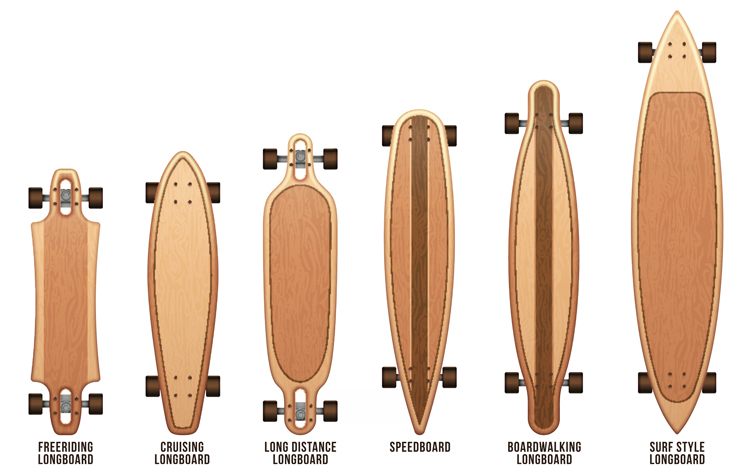
Shape and Design
Longboard skateboards come in different shapes, display multiple templates, provide skaters with more surface for their feet, and shift their weight.
The most common model is the classic pintail, a surfboard-shaped longboard that leads with a soft round nose, widens at the center, and then tapers into a tail.
"These decks often have a concave curve across the width; some have a slight upward curve from nose to tail known as camber," underlines Berger.
"Kicktails are optional, and few feature a kick in the nose."
"Because the trucks and wheels are big and tall, a longboard deck often has fenders that prevent the wheels from making contact with the deck when leaning into a turn."
There are several commercially available longboard shapes - fishtail, hybrid, cruiser - but they're mostly versions of the original, timeless model.
Downhill longboards are slightly different, and they are built to offer stability, speed, total control, and optimal handling.
Their large and low profile require cutaway fenders to provide clearance for the wheels when performing sharp turns.
The deck's contour ranges from nearly flat to slightly concave to a drop-through style, which features an extreme bend and a special truck mount.
